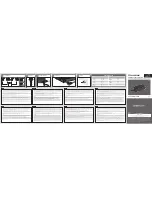
1
ST815
Illumination Sensor with LCD
The Illumination Sensor with LCD (refer to as Illumination Sensor hereafter) is a
Z-Wave
TM
enabled device which is fully compatible with any Z-Wave
TM
enabled
network. Z-Wave
TM
enabled devices displaying the Z-Wave
TM
logo can also be
used with it regardless of the manufacturer, and ours can also be used in other
manufacturer’s Z-Wave
TM
enabled networks. Inclusion of this sensor on other
manufacturer’s Wireless Controller menu allows remote operation of connected
modules when the sensor is triggered. Z-Wave node in the system also acts as a
repeater, so as to re-transmit the RF signal to ensure that the signal is received by
its intended destination by routing the signal around obstacles and radio dead
spots.
The Illumination Sensor is designed to monitor the current illumination of ambient
environment. The reading of illumination can be reported to you on a regular base
at your disposal. If illumination reaches set points, the sensor will send alerts to
associated devices for further execution (such as trigger on connected lightings).
The Illumination Sensor is suitable for use in darkness and outdoor.
Product Overview
1
LCD Screen
2
Function Keys
Select modes/Change setting
ESC/
Cancel setting/Returning to main display/Learning
▲
Increase settings/enable RF & beep tone
▼
Decrease settings/disable RF & beep tone
3
Illumination Sensor
4
Mounting Bracket
LCD Display
Include to or Exclude from Z-Wave
TM
Network
One of function key (
ESC/
) is used to carry out inclusion, exclusion, association
and reset. When the sensor is first powered up, the reading in RF mode is 00
which implies that it hasn’t been allocated a node ID and cannot work with Z-Wave
enabled devices. The Illumination Sensor will stay “awake” for 10 minutes when
power is first applied to allow time for configuration. Please get familiar with the
terms below before starting the operations.
Function
Description
Inclusion
Add a Z-Wave enabled device (e.g. Illumination Sensor) to Z-Wave
network.
Exclusion
Delete a Z-Wave enabled device (e.g. Illumination Sensor) from the
network.
Association
After inclusion, you have to define the relationship between devices.
Trough association, device can be assigned as master/slave, and specify
which slave is going to be controlled by which master.
Reset
Restore Illumination Sensor to factory default.
The table below lists an operation summary of basic Z-Wave functions. Please
refer to the instructions for your Z-Wave
TM
Certificated Primary Controller to access
the setup function, and to include/exclude/associate devices.
Function Description
LED
Indication
No node ID
The Z-Wave Controller does not allocate a
node ID to the sensor.
The RF reading displays 00
(MODE 5)
1. Have Z-Wave Controller entered
inclusion mode.
Inclusion
2. Pressing
ESC/
key 3 times within 1.5
seconds will enter inclusion mode.
flashes
Side View
Front View
1
2
3
Rear View
LUX Trigger ON
Linking Signal
Countdown Timer
Unit of Illumination
Radio Frequency
Status
Lux value reaches
3000 LUX
Low Battery
LUX Trigger OFF
Beep tone ON
4


























